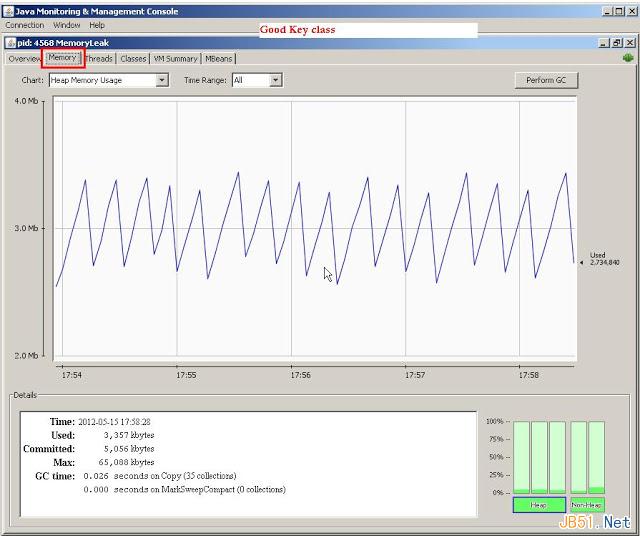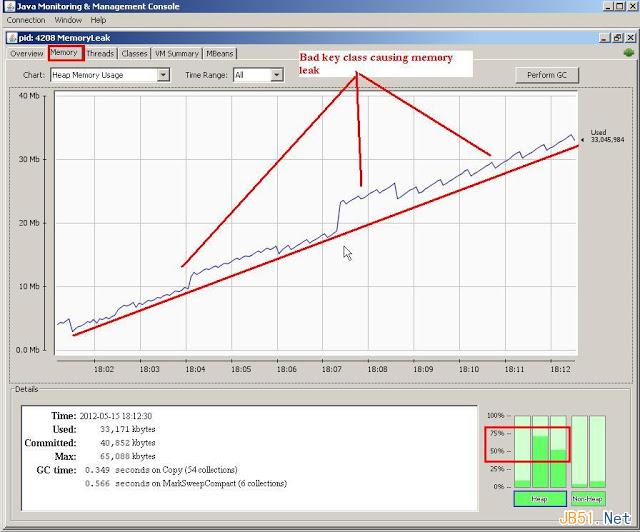Typical memory leak problems and solutions in Java
Q: How can memory leak occur in Java?
A: In Java, there are many reasons for memory leaks. A typical example is a Key class that does not implement the hasCode and
equals methods and is saved in a HashMap. In the end, many duplicate objects will be generated. All memory leaks
will eventually throw an OutOfMemoryError exception. The following is a brief example of simulating a memory leak through an infinite loop
.
import java.util.HashMap;
import java.util.Map;
public class MemoryLeak {
public static void main(String[] args) {
Map<Key, String> map = new HashMap<Key, String>(1000);
int counter = 0;
while (true) {
// creates duplicate objects due to bad Key class
map.put(new Key("dummyKey"), "value");
counter++;
if (counter % 1000 == 0) {
System.out.println("map size: " + map.size());
System.out.println("Free memory after count " + counter
+ " is " + getFreeMemory() + "MB");
sleep(1000);
}
}
}
// inner class key without hashcode() or equals() -- bad implementation
static class Key {
private String key;
public Key(String key) {
this.key = key;
}
}
//delay for a given period in milli seconds
public static void sleep(long sleepFor) {
try {
Thread.sleep(sleepFor);
} catch (InterruptedException e) {
e.printStackTrace();
}
}
//get available memory in MB
public static long getFreeMemory() {
return Runtime.getRuntime().freeMemory() / (1024 * 1024);
}
}The results are as follows:
map size: 1000 Free memory after count 1000 is 4MB map size: 2000 Free memory after count 2000 is 4MB map size: 1396000 Free memory after count 1396000 is 2MB map size: 1397000 Free memory after count 1397000 is 2MB map size: 1398000 Free memory after count 1398000 is 2MB map size: 1399000 Free memory after count 1399000 is 1MB map size: 1400000 Free memory after count 1400000 is 1MB map size: 1401000 Free memory after count 1401000 is 1MB ..... ..... map size: 1452000 Free memory after count 1452000 is 0MB map size: 1453000 Free memory after count 1453000 is 0MB Exception in thread "main" java.lang.OutOfMemoryError: Java heap space at java.util.HashMap.addEntry(HashMap.java:753) at java.util.HashMap.put(HashMap.java:385) at MemoryLeak.main(MemoryLeak.java:10)
Q: How to solve the above memory leak?
A: Implement the equals and hasCode methods of the Key class.
.....
static class Key {
private String key;
public Key(String key) {
this.key = key;
}
@Override
public boolean equals(Object obj) {
if (obj instanceof Key)
return key.equals(((Key) obj).key);
else
return false;
}
@Override
public int hashCode() {
return key.hashCode();
}
}
.....Re-executing the program will get the following results:
map size: 1 Free memory after count 1000 is 4MB map size: 1 Free memory after count 2000 is 4MB map size: 1 Free memory after count 3000 is 4MB map size: 1 Free memory after count 4000 is 4MB ... Free memory after count 73000 is 4MB map size: 1 Free memory after count 74000 is 4MB map size: 1 Free memory after count 75000 is 4MB
Q: In actual scenarios, how do you find memory leaks?
A: Get the thread ID through the following code
C:\>jps 5808 Jps 4568 MemoryLeak 3860 Main
Open jconsole through the command line
C:\>jconsole 4568
The Key class that implements hasCode and equals and the chart that does not implement it are as follows:
No memory leak:

Cause memory leak:

More typical memory in Java For articles related to leakage problems and solutions, please pay attention to the PHP Chinese website!

Hot AI Tools

Undresser.AI Undress
AI-powered app for creating realistic nude photos

AI Clothes Remover
Online AI tool for removing clothes from photos.

Undress AI Tool
Undress images for free

Clothoff.io
AI clothes remover

AI Hentai Generator
Generate AI Hentai for free.

Hot Article

Hot Tools

Notepad++7.3.1
Easy-to-use and free code editor

SublimeText3 Chinese version
Chinese version, very easy to use

Zend Studio 13.0.1
Powerful PHP integrated development environment

Dreamweaver CS6
Visual web development tools

SublimeText3 Mac version
God-level code editing software (SublimeText3)

Hot Topics
 Top 4 JavaScript Frameworks in 2025: React, Angular, Vue, Svelte
Mar 07, 2025 pm 06:09 PM
Top 4 JavaScript Frameworks in 2025: React, Angular, Vue, Svelte
Mar 07, 2025 pm 06:09 PM
This article analyzes the top four JavaScript frameworks (React, Angular, Vue, Svelte) in 2025, comparing their performance, scalability, and future prospects. While all remain dominant due to strong communities and ecosystems, their relative popul
 How do I implement multi-level caching in Java applications using libraries like Caffeine or Guava Cache?
Mar 17, 2025 pm 05:44 PM
How do I implement multi-level caching in Java applications using libraries like Caffeine or Guava Cache?
Mar 17, 2025 pm 05:44 PM
The article discusses implementing multi-level caching in Java using Caffeine and Guava Cache to enhance application performance. It covers setup, integration, and performance benefits, along with configuration and eviction policy management best pra
 Node.js 20: Key Performance Boosts and New Features
Mar 07, 2025 pm 06:12 PM
Node.js 20: Key Performance Boosts and New Features
Mar 07, 2025 pm 06:12 PM
Node.js 20 significantly enhances performance via V8 engine improvements, notably faster garbage collection and I/O. New features include better WebAssembly support and refined debugging tools, boosting developer productivity and application speed.
 How does Java's classloading mechanism work, including different classloaders and their delegation models?
Mar 17, 2025 pm 05:35 PM
How does Java's classloading mechanism work, including different classloaders and their delegation models?
Mar 17, 2025 pm 05:35 PM
Java's classloading involves loading, linking, and initializing classes using a hierarchical system with Bootstrap, Extension, and Application classloaders. The parent delegation model ensures core classes are loaded first, affecting custom class loa
 Iceberg: The Future of Data Lake Tables
Mar 07, 2025 pm 06:31 PM
Iceberg: The Future of Data Lake Tables
Mar 07, 2025 pm 06:31 PM
Iceberg, an open table format for large analytical datasets, improves data lake performance and scalability. It addresses limitations of Parquet/ORC through internal metadata management, enabling efficient schema evolution, time travel, concurrent w
 Spring Boot SnakeYAML 2.0 CVE-2022-1471 Issue Fixed
Mar 07, 2025 pm 05:52 PM
Spring Boot SnakeYAML 2.0 CVE-2022-1471 Issue Fixed
Mar 07, 2025 pm 05:52 PM
This article addresses the CVE-2022-1471 vulnerability in SnakeYAML, a critical flaw allowing remote code execution. It details how upgrading Spring Boot applications to SnakeYAML 1.33 or later mitigates this risk, emphasizing that dependency updat
 How can I implement functional programming techniques in Java?
Mar 11, 2025 pm 05:51 PM
How can I implement functional programming techniques in Java?
Mar 11, 2025 pm 05:51 PM
This article explores integrating functional programming into Java using lambda expressions, Streams API, method references, and Optional. It highlights benefits like improved code readability and maintainability through conciseness and immutability
 How do I use Maven or Gradle for advanced Java project management, build automation, and dependency resolution?
Mar 17, 2025 pm 05:46 PM
How do I use Maven or Gradle for advanced Java project management, build automation, and dependency resolution?
Mar 17, 2025 pm 05:46 PM
The article discusses using Maven and Gradle for Java project management, build automation, and dependency resolution, comparing their approaches and optimization strategies.






